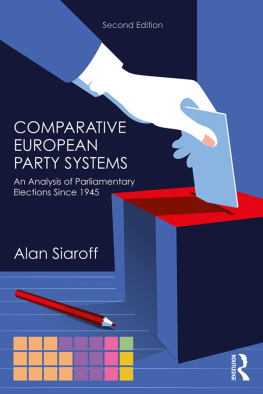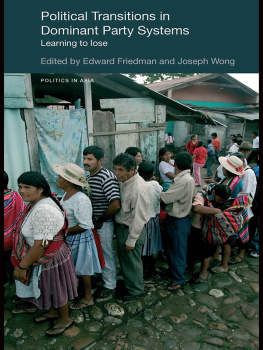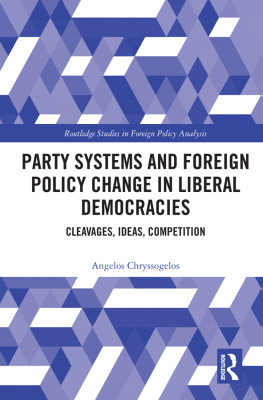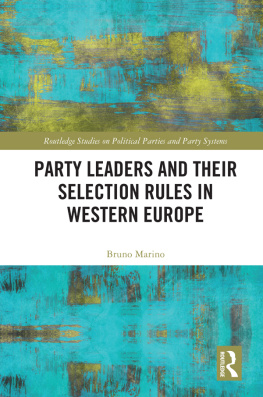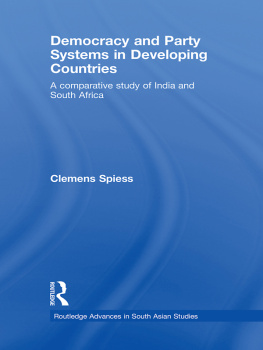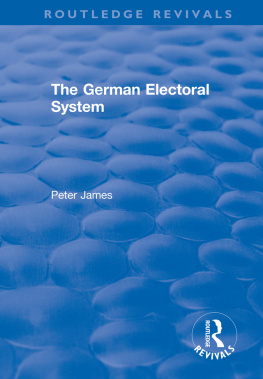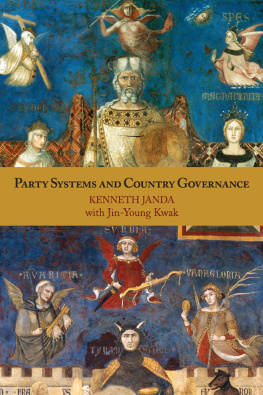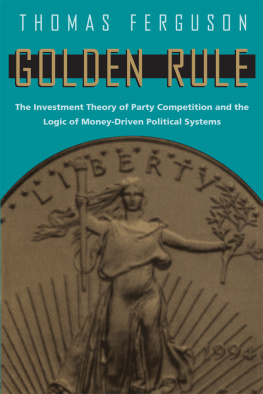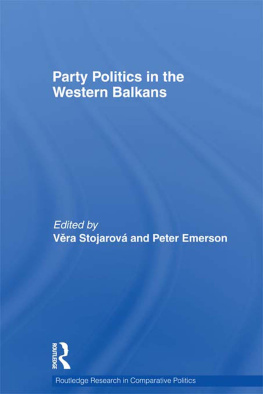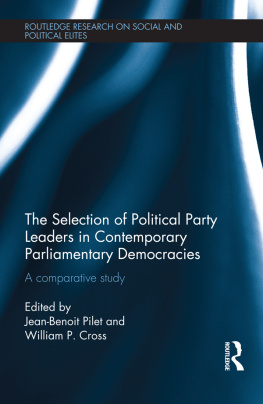Comparative European Party Systems
Comparative European Party Systems, Second Edition, provides a comprehensive analysis across 48 party systems of party competition, electoral systems and their effects, and the classification of party systems and governments from 1945 through late-2018.
The book consists of three parts. provides an analysis of 10 additional country profiles of oscillating regimes such as Russia, Ukraine, and Balkan and Transcaucasus states.
Comparative European Party Systems provides an excellent overview of topical issues in comparative election and party system research and presents a wealth of information and quantitative data. It is a crucial reference for scholars and students of European and comparative politics, elections, electoral systems, and parties and party systems.
Alan Siaroff is Professor of Political Science at the University of Lethbridge, Canada.
Comparative European Party Systems
An Analysis of Parliamentary Elections Since 1945
Second Edition
Alan Siaroff

Second edition published 2019
by Routledge
2 Park Square, Milton Park, Abingdon, Oxon OX14 4RN
and by Routledge
52 Vanderbilt Avenue, New York, NY 10017
Routledge is an imprint of the Taylor & Francis Group, an informa business
2019 Alan Siaroff
The right of Alan Siaroff to be identified as author of this work has been asserted by him in accordance with sections 77 and 78 of the Copyright, Designs and Patents Act 1988.
All rights reserved. No part of this book may be reprinted or reproduced or utilised in any form or by any electronic, mechanical, or other means, now known or hereafter invented, including photocopying and recording, or in any information storage or retrieval system, without permission in writing from the publishers.
Trademark notice: Product or corporate names may be trademarks or registered trademarks, and are used only for identification and explanation without intent to infringe.
First edition published by Routledge 2000
British Library Cataloguing-in-Publication Data
A catalogue record for this book is available from the British Library
Library of Congress Cataloging-in-Publication Data
Names: Siaroff, Alan, author.
Title: Comparative European party systems : an analysis of parliamentary elections since 1945 / Alan Siaroff.
Description: Second edition. | New York : Routledge, 2019. | Includes bibliographical references and index.
Identifiers: LCCN 2018035916 | ISBN 9781138888050 (hardback) | ISBN 9781138888098 (paperback) | ISBN 9781315713694 (master ebook) | ISBN 9781317498773 (web pdf) | ISBN 9781317498766 (ePub) | ISBN 9781317498759 (mobipocket/kindle)
Subjects: LCSH: Political partiesEurope. | EuropePolitics and government1945
Classification: LCC JN50 .S57 2019 | DDC 324.2094dc23
LC record available at https://lccn.loc.gov/2018035916
ISBN: 978-1-138-88805-0 (hbk)
ISBN: 978-1-138-88809-8 (pbk)
ISBN: 978-1-315-71369-4 (ebk)
Typeset in Bembo
by Apex CoVantage, LLC
In memory of my parents, whose lives covered almost all of the years under analysis here.
Contents
Part I
Comparative analysis
Part II
Individual case analyses of longstanding democratic polities
Part III
Individual case analyses of oscillating regimes
Figures
Tables
#C | number of (European) commissioners |
#D | number of (subnational) electoral districts |
#M | number of (cabinet) ministers |
#S | number of seats |
%V | percentage of the vote (that is, of valid votes) |
1PSS | one-party seat share |
2PSS | two-party seat share |
2PVS | two-party vote share |
DISP | disproportionality |
ED | electoral decisiveness |
EFRG | electoral fragmentation |
EM | earned majority |
ENEP | effective number of electoral parties |
ENPP | effective number of parliamentary parties |
EP | European Parliament |
F(+I)P | formation (and investiture) period |
GC | grand coalition |
HP | hung parliament |
(I) | independents (in a cabinet) |
ICD | index of coalition difficulty |
Ind. | Independent (designating a prime minister) |
MAJ | majority |
MIN | minority |
MM | manufactured majority |
MMP | mixed-member proportional |
MP | multi-party |
MPs | members of parliament |
MWC | minimal-winning coalition |
MWGC | minimal-winning grand coalition |
NATO | North Atlantic Treaty Organization |
ngf | no government formed |
NI | Non-Inscrits (Non-attached members of the European Parliament) |
NP | inverse of the seat share of the largest party |
NbP | mean of ENPP and NP |
OVC | oversized coalition |
OVGC | oversized grand coalition |
P2%S | number of parties with 2 percent of the seats |
P15%V | number of parties with 15 percent of the vote |
pe | post-election |
PF | party family |
PG | party groups (in the European Parliament) |
PR | proportional representation |
PRFG | parliamentary fragmentation |
SBLP | seat bias in favour of the largest party |
SB2P | seat bias in favour of the two largest parties |
SMP | single-member plurality |
SP | single-party |
SR1:2 | seat ratio first to second party |
SR2:3 | seat ratio second to third party |
STV | single transferable vote |
TO | turnout |
TVOL | total volatility |
WV | wasted votes |
Introduction and context
Where is Europe?
This work seeks to be a comprehensive analysis of European party systems. In terms of what and where Europe is, however, debate persists. Geographers would tend to define it broadly, up to the Ural Mountains at the start of Siberia. In contrast, historically such areas as Russia and Spain have at times not been included (Wallace 1990). In the current context one may be tempted to begin with the European Union; however, this only contains 28 members (including still in 2018 the United Kingdom pending its Brexit). A better place to start is in fact with the Strasbourg-based Council of Europe.

